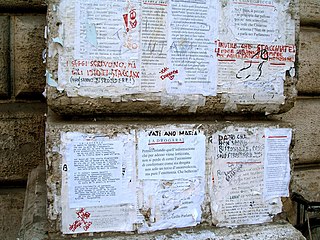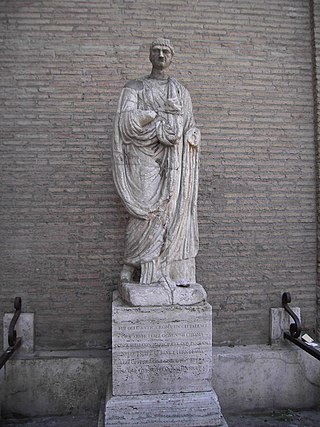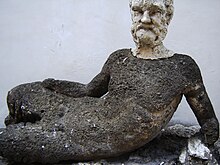
Villa Borghese is a landscape garden in Rome, containing a number of buildings, museums and attractions. It is the third-largest public park in Rome, after the ones of the Villa Doria Pamphili and Villa Ada. The gardens were developed for the Villa Borghese Pinciana, built by the architect Flaminio Ponzio, developing sketches by Scipione Borghese, who used it as a villa suburbana, or party villa, at the edge of Rome, and to house his art collection. The gardens as they are now were remade in the late 19th century.

Pasquino or Pasquin is the name used by Romans since the early modern period to describe a battered Hellenistic-style statue perhaps dating to the third century BC, which was unearthed in the Parione district of Rome in the fifteenth century. It is located in a piazza of the same name on the northwest corner of the Palazzo Braschi ; near the site where it was unearthed.

The Victor Emmanuel II National Monument, also known as the Vittoriano or Altare della Patria, is a large national monument built between 1885 and 1935 to honour Victor Emmanuel II, the first king of a unified Italy, in Rome, Italy. It occupies a site between the Piazza Venezia and the Capitoline Hill. The monument was realized by Giuseppe Sacconi.

Campo Marzio is the 4th rione of Rome, Italy, identified by the initials R. IV. It belongs to the Municipio I and covers a smaller section of the area of the ancient Campus Martius. The logo of this rione is a silver crescent on a blue background.

The Acqua Vergine is one of several Roman aqueducts that deliver pure drinking water to Rome. Its name derives from its predecessor Aqua Virgo, which was constructed by Marcus Vipsanius Agrippa in 19 BC. Its terminal castellum is located at the Baths of Agrippa, and it served the vicinity of Campus Martius through its various conduits. In an effort to restore fresh water to Rome during the Renaissance, Pope Nicholas V, in 1453, renovated the main channels of the Aqua Virgo and added numerous secondary conduits under Campo Marzio. The original terminus, called a mostra, which means showpiece, was the stately, dignified wall fountain designed by Leon Battista Alberti in Piazza dei Crociferi. Due to several additions and modifications to the end-most points of the conduits during the years that followed, during the Renaissance and Baroque periods, the Acqua Vergine culminated in several magnificent mostre - the Trevi Fountain and the fountains of Piazza del Popolo.

Piazza del Popolo is a large urban square in Rome. The name in modern Italian literally means "People's Square", but historically it derives from the poplars after which the church of Santa Maria del Popolo, in the northeast corner of the piazza, takes its name.

Via Margutta is a narrow street in the centre of Rome, near Piazza del Popolo, accessible from Via del Babuino in the ancient Campo Marzio neighborhood also known as "the foreigner's quarter". Mount Pincio is nearby. Via Margutta originally was home to modest craftsmen, workshops and stables, but now hosts many art galleries and fashionable restaurants.

Santa Maria dei Miracoli and Santa Maria di Montesanto are two churches in Rome.

The Via del Corso is a main street in the historical centre of Rome. It is straight in an area otherwise characterized by narrow meandering alleys and small piazzas. Considered a wide street in ancient times, the Corso is approximately 10 metres wide, and it only has room for two lanes of traffic and two narrow sidewalks. The northern portion of the street is a pedestrian area. The length of the street is roughly 1.5 kilometres.

The talking statues of Rome or the Congregation of Wits provided an outlet for a form of anonymous political expression in Rome. Criticisms in the form of poems or witticisms were posted on well-known statues in Rome, as an early instance of bulletin board. It began in the 16th century and continues to the present day.

Flaminio–Piazza del Popolo is an underground station on Line A of the Rome Metro, inaugurated in 1980. The station is situated on the large Piazzale Flaminio, in the Flaminio quarter outside the Aurelian Walls, next to Piazza del Popolo, and is near the Campus Martius.

Marphurius or Marforio is one of the talking statues of Rome. Marforio maintained a friendly rivalry with his most prominent rival, Pasquin. As at the other five "talking statues", pasquinades—irreverent satires poking fun at public figures—were posted beside Marforio in the 16th and 17th centuries.

Il Facchino is one of the talking statues of Rome. Like the other five "talking statues", pasquinades - irreverent satires poking fun at public figures - were posted beside Il Facchino in the 14th and 15th centuries.

Abbot Luigi is one of the talking statues of Rome. Like the other five "talking statues", pasquinades – irreverent satires poking fun at public figures – were posted beside Abate Luigi in the 14th and 15th centuries.

The Gardens of Vatican City, also informally known as the Vatican Gardens in Vatican City, are private urban gardens and parks which cover more than half of the country, located in the west of the territory and owned by the Pope. There are some buildings, such as Vatican Radio and the Governor's Palace, within the gardens.

Via del Babuino is a street in the historic centre of Rome (Italy), located in the rione Campo Marzio. It connects Piazza del Popolo to Piazza di Spagna and is part of the complex of streets known as Tridente.

A pasquinade or pasquil is a form of satire, usually an anonymous brief lampoon in verse or prose, and can also be seen as a form of literary caricature. The genre became popular in early modern Europe, in the 16th century, though the term had been used at least as early as the 4th century, as seen in Augustine's City of God. Pasquinades can take a number of literary forms, including song, epigram, and satire. Compared with other kinds of satire, the pasquinade tends to be less didactic and more aggressive, and is more often critical of specific persons or groups.

Via dei Coronari is a street in the historic center of Rome. The road, flanked by buildings mostly erected in the 15th and the 16th century, belongs entirely to the rione Ponte and is one of the most picturesque roads of the old city, having maintained the character of an Italian Renaissance street.




















